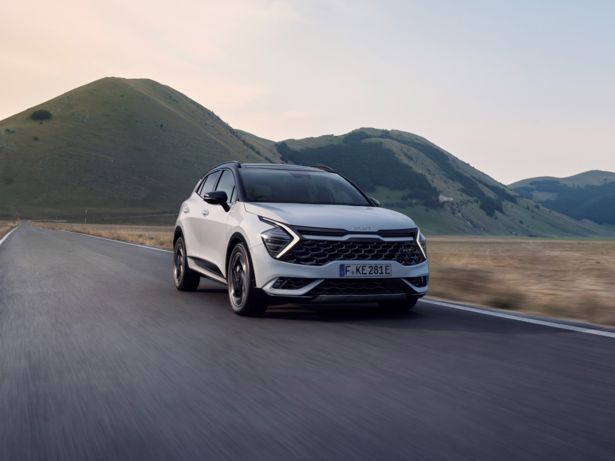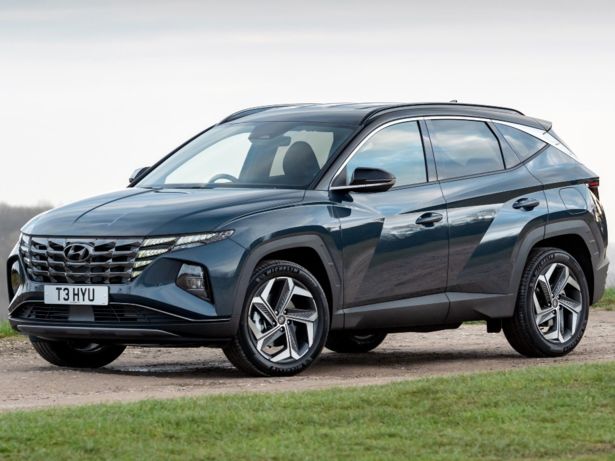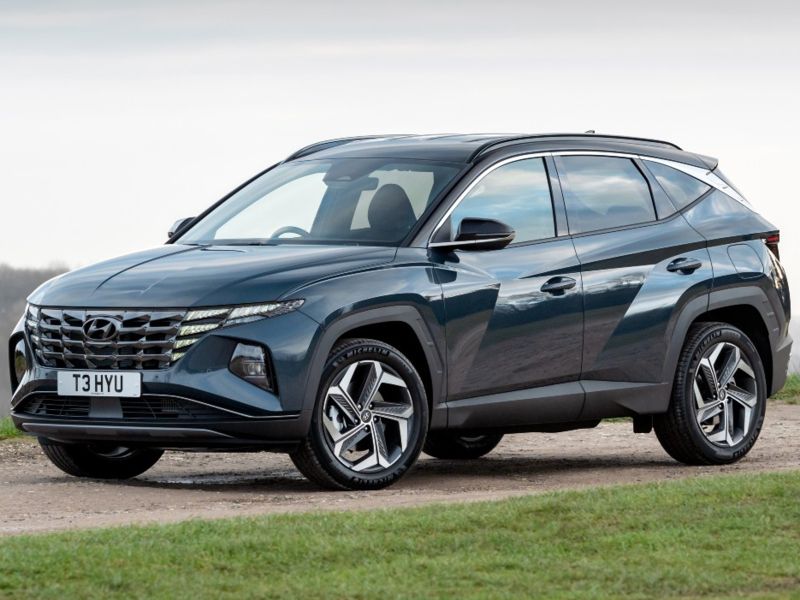
Kia
Sportage Plug-in Hybrid (2022-)
Full Access first month £5, then £11.99 per month, cancel at any time

SUVs are the most popular type of new car in the UK, and two of the best selling are the Kia Sportage and Hyundai Tucson. We reveal what sets them apart and which one to go for.
Although they share a great deal, including the same vehicle platform and similar engines, there are plenty of subtle (and some more obvious) differences between the two models, which have been borne out in our lab tests and annual reliability survey.
Which? members can log in to see the full version of this article, complete with test scores and reliability information. Alternatively, join Which? today to get instant access.
| Kia Sportage (2022-) | Hyundai Tucson (2021-) | |
| Price from | £27,879 | £29,991 |
| Petrol (inc. mild hybrid) options | ✓ | ✓ |
| Full hybrid options | ✓ | ✓ |
| Plug-in hybrid options | ✓ | ✓ |
| Diesel options | ✓ (used only) | ✗ |
| Dimensions | 4.5 x 2.13 x 1.65m | 4.51 x 2.09 x 1.65m |
| Turning circle | 11.65m - 11.95m | 11.90m - 11.95m |

The fifth-generation Kia Sportage was launched in 2022 with a broad range of power options on offer: petrol mild-hybrid, full hybrid and plug-in hybrid. It offers sharp looks and lots of technology, while power ranges from 115hp right up to 265hp. Diesel and pure-petrol variants are now available used only.
Most Sportage models are front-wheel-drive, but all-wheel-drive is available in certain engine and trim level configurations.

Hyundai’s Tucson badge has been around since 2004. The fourth-generation of this medium-sized SUV was launched in the UK in 2021 with styling that makes it stand out from the crowd. There are currently petrol and mild-hybrid petrol models, as well as full-hybrid and plug-in hybrid options. They all use a 1.6 litre engine which, in the pure petrol and mild-hybrid models, produces 150hp.
The current Tucson petrol range is exclusively two-wheel drive – a four-wheel drive option was originally available at launch, but has since gone off sale. All mild-hybrid models are fitted with a seven-speed automatic gearbox, while pure-petrol versions come with a six-speed manual gearbox.
Both models use the same basic platform (a shared set of basic engineering features), which was jointly developed by Kia and Hyundai. They use the same type of Hyundai engine and both were facelifted in 2024 (although the facelifted Sportage is yet to be introduced to Europe).
Of the current versions, we've lab tested the following models:
We’re also currently lab-testing a facelifted Tucson PHEV and will soon be publishing our review – sign up to our cars newsletter to be the first to know when our review is published.
Best medium and large SUVs: find out which models performed best in our tests
| Which? test | Kia Sportage (2022-) | Kia Sportage Plug-in Hybrid (2022-) | Hyundai Tucson (2021-) | Hyundai Tucson Hybrid (2021-) |
| Visibility | ||||
| Smoothness of power delivery | ||||
| Driving stability | ||||
| Cabin layout | ||||
| Overall |
Log in or join Which? to unlock this table
Our full test scores are exclusive to Which? members, but perhaps the most significant difference is with the cabin layouts: the Sportage’s touchscreen is more complicated to navigate than the system in the pre-facelift Tucson, while our lab thought the rotary controls in the Sportage’s cabin were unintuitive.
Bear in mind that the facelifted Tucson has a completely different interior setup which features more physical controls.
Like most modern cars, both the Sportage and Tucson have wide rear roof pillars, which does affect rearward visibility.
However, all models in the current Sportage and Tucson ranges come with plenty of parking aids, which help to mitigate this.
| 0-4 year reliability | Kia Sportage (2022-) | Kia Sportage Plug-in Hybrid (2022-) | Hyundai Tucson (2021-) | Hyundai Tucson Hybrid (2021-) |
| Owners that reported one or more faults | ||||
| Owners that reported breakdowns | ||||
| Average time off road | ||||
| Overall score |
Log in or join Which? to unlock this table
Reliability is another area where each model performs, but our survey data revealed some interesting differences.
Faulty cars of each hybrid version are off the road for less time when faulty compared to pure-petrol models. While the Sportage Plug-in Hybrid has a lower fault rate, its breakdown rate is much higher than the non-PHEV Sportage and the Tucson.
Looking at the most common individual faults across all models, owners reported fuel cap issues, along with problems with the exterior, non-engine electrics and the 12V battery.
To find out detailed reliability information for all models, join Which? today.
Most reliable cars for 2025: view the models that scored highest in our latest survey
| Which? test score | Kia Sportage (2022-) | Kia Sportage Plug-in Hybrid (2022-) | Hyundai Tucson (2021-) | Hyundai Tucson Hybrid (2021-) |
| Entry and exit | ||||
| Seat comfort | ||||
| Ride quality | ||||
| Quietness | ||||
| Seat space | ||||
| Boot space | ||||
| Overall |
Log in or join Which? to unlock this table
The Sportage and Tucson score similarly here too. In all models, space up front is good, with enough legroom for anyone up to 1.95 metres (6ft 5in) tall, plus headroom for even taller people (though there’s slightly less front space in the Tucson Hybrid than the other cars). All offer the same amount of rear passenger space, accommodating people up to 2m (6ft 6in) tall.
| Which? measurement | Kia Sportage (2022-) | Kia Sportage Plug-in Hybrid (2022-) | Hyundai Tucson (2021-) | Hyundai Tucson Hybrid (2021-) |
| Boot space (seats up) | 395 litres | 395 litres | 410 litres | 440 litres |
| Boot space (seats down) | 1,395 litres | 1,395 litres | 1,395 litres | 1,425 litres |
While each car scores very well for boot space, the Tucson Hybrid has the largest when the rear seats are used or folded. The Sportage is lower to the ground, making it easier to load luggage than with the Tucson.
| Kia Sportage (2022-) | Kia Sportage Plug-in Hybrid (2022-) | Hyundai Tucson (2021-) | Hyundai Tucson Hybrid (2021-) | |
| Euro NCAP rating | ||||
| Which? safety kit rating |
Both the Tucson and Sportage have five-star Euro NCAP scores and come with a decent range of safety kit as standard.
On the Sportage, standard safety equipment includes forward collision-avoidance assist, lane-keep assist and detection for pedestrians, cyclists and junctions. However, only the highest-spec Sportage comes with the best safety tech, which includes blind-spot assist and parking collision avoidance assist.
With the Tucson, all models come with AEB, front-collision avoidance, driver-attention warning and downhill brake-control systems. All but the cheapest Tucson models have junction-turning detection, while only top-range models get a blind-spot monitor and an uprated front-collision assistance system that can detect vulnerable road users when turning into junctions.
| Which? test | Kia Sportage (2022-) | Kia Sportage Plug-in Hybrid (2022-) | Hyundai Tucson (2021-) | Hyundai Tucson Hybrid (2021-) |
| Tested engine | 1.6 CRDI AWD DCT | 1.6 T-GDI Plug-In Hybrid AWD | 1.6 T-GDI 48V-Mild Hybrid Prime DCT | 1.6 T-GDI Hybrid Prime Automatic |
| Tested fuel type | Diesel mild hybrid | Petrol plug-in hybrid | Petrol mild hybrid | Petrol hybrid |
| Combined test (mpg) | ||||
| Urban (mpg) | ||||
| Countryside (mpg) | ||||
| Motorway (mpg) |
Log in or join Which? to unlock this table
As you might expect with a plug-in hybrids, significant running cost savings can be achieved with the Sportage PHEV when running it with the battery only. However, our tests revealed fuel consumption rockets when it’s empty, especially on the motorway.
If you can’t charge at home, the Tucson Hybrid should be the cheapest to run in most situations, with the (used-only) diesel Sportage offering better motorway economy.
To find out detailed fuel efficiency information for all models, join Which? today.
If you can charge at home, the Sportage PHEV is worth considering as it’s the most economical and has all of the benefits of the diesel Sportage. Otherwise, we think the Tucson Hybrid is the better choice, as it’s more economical in urban areas than the non-hybrid models and has the largest boot.
Hyundai’s five-year, unlimited mileage warranty is appealing for high-mileage drivers, while Kia’s seven-year warranty holds more appeal for those that drive less.
The Tucson Hybrid also has a lower list price in our preferred trim level (£41,040 vs £45,795) and is cheaper to finance over 3 years too (£399.11 vs £551.83)c.
cAssumes £7,000 customer deposit, 6,000 miles per year, PCP. Figures relate to Hyundai Tucson Hybrid N Line S FWD and Kia Sportage Plug-in Hybrid GT-Line S and were checked on 21/03/2025.

Sportage Plug-in Hybrid (2022-)
Full Access first month £5, then £11.99 per month, cancel at any time

Tucson hybrid (2021-)
Full Access first month £5, then £11.99 per month, cancel at any time

Sportage (2022-)
Full Access first month £5, then £11.99 per month, cancel at any time

Tucson (2021-)
Full Access first month £5, then £11.99 per month, cancel at any time
It’s fair to say that the Tucson and Sportage have plenty of competitors.
Other popular hybrid SUVs include the Nissan Qashqai e-Power, Honda ZR-V and Ford Kuga. If you're after a plug-in hybrid, it's worth checking out our reviews of the Cupra Formentor, Toyota RAV4 and Mazda CX-60. Click through to our reviews to find out how they all fared.
And for even more options, take a look at our guide to the best family cars for 2025.
Drive smarter and cut costs using our expert advice. Get our Cars newsletter – it's free monthly